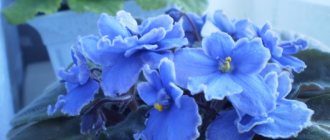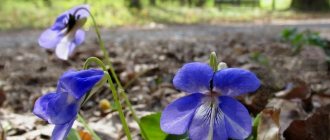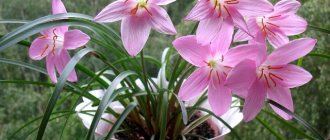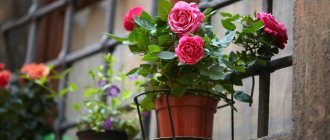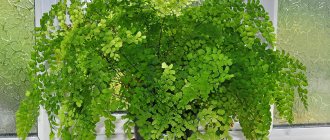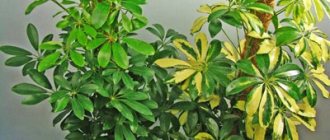Author: Elena N. https://floristics.info/ru/index.php?option=com_contact&view=contact&id=19 Category: Houseplants Published: January 16, 2019Last edits: January 11, 2021
- Growing from seeds
- Clerodendrum does not bloom
- Thomson's clerodendrum (Clerodendrum thomsoniae)
The plant clerodendrum (lat. Clerodendrum) , or clerodendron , is a deciduous or evergreen tree or shrub of the Verbenaceae family of the order Lamiaceae. In nature, clerodendrum flowers are found mostly in the tropics of Africa, Asia and South America. In total, about 400 species of clerodendrum are known. The name of the plant is translated as “tree of fate”; it is sometimes called “volkameria” or “innocent love”. Although clerodendrum was introduced into culture several centuries ago, the clerodendrum flower has been grown as a house plant not so long ago, but its popularity in this role among flower growers and designers is growing very quickly.
Planting and caring for clerodendrum
- Flowering: from June to early autumn, fragrant clerodendrum blooms almost all year round.
- Lighting: bright diffused light (eastern and western window sills, shading required on the southern window).
- Temperature: 18-25 ˚C during the period of active growth and flowering, 13-15 ˚C during the dormant period.
- Watering: abundant, the top layer of the substrate should dry out between waterings.
- Air humidity: high, requiring nightly spraying in the warm season and keeping away from heating devices in winter.
- Feeding: from mid-spring to late summer, twice a month with complex mineral fertilizers for flowering plants.
- Dormant period: after flowering - in autumn and winter.
- Pruning: at the beginning of the growing season.
- Transplantation: at the beginning of active growth: young plants are replanted annually, adults - every 2-3 years.
- Reproduction: seeds and cuttings.
- Pests: aphids, whiteflies and spider mites.
- Diseases: chlorosis, rot.
Read more about growing clerodendrum below.
Possible problems
The most common problems that may arise when growing Clerodendrum Prospero:
- No flowering. Most often, this problem occurs due to improper care. To avoid it, it is necessary to ensure proper wintering, namely:
- After the next flowering, you need to ensure the air temperature is 12-15 degrees.
- During the cold season, reduce watering, but do not allow the earthen clod to dry out.
- Yellowing of leaves . If the plant is not affected by diseases and pests, and its leaves have turned yellow, the watering regime should be reconsidered. In the warm season, lack of moisture leads to yellowing of the leaves.
- Damage by diseases and pests . If diseases or pests are detected, chemical treatment is carried out.
As you can see, the process of growing Clerodendrum Prospero does not seem complicated, but some nuances need to be taken into account. Thanks to its beauty, this marvelous flower becomes more popular every year and is often grown even by ordinary amateurs. Snow-white flowers in cascading clusters will decorate any interior and give a truly wonderful aroma.
Features of cultivation
- The leaves of clerodendrum are bright green, simple, heart-shaped, with jagged or solid edges, a rough “quilted” surface, 20 to 30 cm long, arranged oppositely or whorled on the stem. Flexible shoots in the lower part become woody very quickly. The indoor clerodendrum flower is grown for its beautiful flowers with long stamens, collected in terminal corymbs or racemes.
- Clerodendrum flowers in most species have the shape of a butterfly, but in Clerodendrum philippines and Clerodendrum benguet the inflorescences resemble bouquets of unusual shapes.
- Both flowers and leaves of most clerodendrums emit a scent, and each species has its own.
- The indoor flower clerodendrum is represented mainly by two species - Thompson's clerodendrum and brilliant clerodendrum, although other representatives of the genus grow well at home.
- Clerodendrum can be given various forms (ampeloid, bush-like, standard) using pruning and pinching.
- Caring for clerodendrum flowers is not difficult - they are hardy, unpretentious and at the same time fabulously beautiful and also fragrant.
For complete comfort
Suitable soil will be soil that is as similar in composition to the natural one for this foreign guest. Knowing the required proportions, you can prepare it yourself or purchase a ready-made mixture at a flower shop.
In both cases, it is important to disinfect before planting; it will prevent various diseases of the seedlings.
Caring for clerodendrum at home
Rules of care
For healthy growth and full flowering, tropical forest plants need conditions that are as close to natural as possible. Clerodendrum at home prefers window sills facing south, west or east - it needs bright light, but with protection from direct sunlight. The optimal temperature in summer is between 18-25 ºC; during the dormant period, which occurs in the winter months, the plant needs coolness - no higher than 15 ºC.
The air humidity in the room with clerodendrum should be high, so you will have to spray the plant with soft, settled water every night in the warm season, and in winter, remove the flower pot away from heating appliances.
Clerodendrum should be watered abundantly with soft water, but the top layer of soil should dry out between waterings. During the dormant period, soil moistening is carried out according to the following principle: the cooler it is in the room, the less often we water it, but the earth ball should not dry out completely. From mid-spring to the end of summer, clerodendrum is fertilized twice a month with complex fertilizers for flowering indoor plants; no fertilizing is needed in autumn and winter.
- Shade-tolerant indoor plants - care
Clerodendrum flowering
Depending on the species, clerodendrum begins to bloom in June, and these plants fade in September. It is interesting to observe how white bracts appear on the still bare shoots of Thompson's clerodendrum in early spring, from which crimson corollas up to 2.5 cm in diameter are formed. The beautiful clerodendrum blooms from June to September with panicles of purple flowers, and the fragrant clerodendrum blooms almost all year round. Anyone who has seen clerodendrum bloom will definitely want to see this magic again.
Trimming
Caring for clerodendrum involves mandatory annual pruning of the plant at the beginning of the period of active growth. Caring for Thompson's clerodendrum, for example, in addition to removing dried or weak branches, requires shortening all shoots by a third of the length, which should stimulate abundant flowering, as well as intensive growth and branching of young side shoots, on which inflorescences are formed. Clerodendrum is also pruned in order to form a crown - if you want the clerodendrum to grow as a bush, you need to greatly shorten the shoots when pruning in spring, otherwise you will have to install support for them later.
How to prune clerodendrum to make a tree? The standard form is created as follows: all shoots are removed, except for one, the strongest, which is cut off at a height of 50-70 cm, and then all shoots that appear in the apex area are pinched in order to create a crown due to their branching. If sprouts appear on the stem below the crown, they are removed.
Transfer
Growing clerodendrum requires replacing old soil with new soil from time to time; in addition, an overgrown plant may require a larger pot. Plants are replanted at the beginning of active growth after pruning. Young plants need annual replanting, but older plants need to change the soil and pot once every two to three years. The soil for clerodendrum should be nutritious and slightly acidic (pH 5-6). You can use store-bought soil, adding sand to it, or make your own from peat, coarse sand, leaf and clay soil in equal parts.
Before replanting the plant, the new soil must be disinfected by steaming, oven or microwave. How to transplant clerodendrum? Take a pot 2 cm in height and 2 cm in diameter larger than the old one, place a layer of drainage three centimeters high in it and transfer the plant from the old pot to the new one, being careful not to damage the root ball. Add the required amount of new substrate to fill the voids in the pot and water the plant. If your clerodendrum needs support in the future, dig it in when replanting so that you don’t have to stick it into the pot later, damaging the roots of the plant.
Reviews from flower growers
I immediately replant all newly acquired plants and treat them for pests.
For clairs, I take teravit + coco soil + vermiculite (by eye, so that the soil is light). I don’t create any special conditions. I take small containers for transplantation, because until the root has mastered the earthen ball, the top does not grow. Claires grow quite quickly, do not get carried away with fertilizing. They bloom at the ends of the shoots, so pinch and trim as needed. Fanya https://frauflora.ru/viewtopic.php?t=4439
This species loves humidity and water.
Moreover, this flower is immediately noticeable when it is “thirsty.” Its wide, slightly rough leaves of emerald color droop and hang like rags. Clerodendrum in nature is a vine. Therefore, it intensively produces shoots that need support. If you want to form a tree, then the shoots must be pruned. In the summer, I take my clerodendrum to the balcony (he really likes it there) and allow it to send out shoots along special ropes. You also need to trim the shoots in order for your flower to bloom. This usually happens closer to March. It blooms for a very long time, several months. ElFeYa https://otzyvy.pro/reviews/otzyvy-klerodendrum-112304.html
I really want to start growing this plant.
I am especially attracted to flowers. I know that red corollas usually fade before the calyxes. And then these cups change color to bright red and continue to decorate the clerodendrum for some time. Madlen https://plantus.ru/community/post/vam-znakom-klerodendrum-12489
Clerodendrum loves warmth and good lighting.
Also, the flower needs to be watered abundantly in the summer months and do not forget to spray. Karol_ina https://plantus.ru/community/post/chudesnoe-tsvetenie-klerodendruma-13383
A very beautiful flower, for some reason not very common - it reproduces simply, by cuttings... I once saw a plant on which one hundred and four flowers were blooming at that time - we were not too lazy to count))) believe me, it was a very impressive sight.
I planted it in the office, in almost every office there was a pot with such a miracle, then I retired, the flowers began to wither and completely disappeared (((((and I didn’t think to take at least one home with me - now I’m looking and can’t find ((((by the way, the flower tolerates pruning perfectly, you can shape the crown as you like))))) ALLYENA https://www.liveinternet.ru/community/901126/post359327209/
Other reviews about clerodendrum can be found on the website dacha.help
Clerodendrum propagation
Reproduction of clerodendrum at home is carried out both by generative (seed) and vegetative (cuttings) methods.
- Zephyranthes - care, photos, types
Growing from seeds
Clerodendrum seeds are sown at the end of February or early March in a mixture of turf soil, sand and peat, placed in a greenhouse and kept in good light, ventilating and maintaining moderate soil moisture. You will have to wait a long time for germination - one and a half to two months. When the seedlings have four true leaves, they are planted in separate small containers with a diameter of 6 cm, one seedling at a time or three in a container with a diameter of 11 cm, and as soon as the seedlings have become accustomed and begin to grow, they begin to accustom them to the conditions for adult clerodendrums.
Cuttings
If you already have clerodendrum, you will not need the seed propagation method, because you can always get cuttings for rooting when pruning in spring. Clerodendrum cuttings root easily in water, especially in spring and summer. Once the cuttings have taken root, they are planted in pots approximately 7 cm in diameter and grown under a glass cover, keeping the substrate moist.
As soon as the root system develops and shoots and leaves appear on the cutting, the cutting with the root ball is transferred to a pot with a large (9 cm) diameter, in which it will grow until spring without a cap. A year from the beginning of rooting, transfer the plant to a pot with a diameter of 11 cm in soil for an adult clerodendrum. During this time, be sure to pinch the shoots at least twice to stimulate the growth of side branches.
For aesthetic pleasure
The most interesting section of courting a tropical beauty is its design. It can be given the desired shape.
To do this you will need appropriate pruning:
- small tree - excess branches are removed, leaving one strong shoot. All young shoots are plucked off from it, and it is shortened if it becomes more than half a meter in height;
- voluminous bush - to give this shape the tops are pinched;
- cascading vine - it is enough to shorten the branches a little at the ends in early spring, and also remove the stems with new buds in time.
Pests and diseases
Of all the harmful insects, clerodendrum can be affected by spider mites and whiteflies. Whiteflies hide on the underside of the leaves, and on the top there is a shiny coating from whitefly excrement - honeydew, or honeydew. Spider mites are too small for you to see, but they make their presence known by white dots on the underside of leaf blades and subtle webs on the leaves. You can fight these pests with the same insecticide: dilute one ampoule of Actellik in a liter of water and spray the plant. The treatment can be repeated four times at an interval of three days.
Clerodendrum does not bloom
Very often, on flower forums, beginners try to find out from experienced flower growers why their clerodendrum does not bloom, and each time they are amazed at how simple the reason for their sadness is. Moreover, when they are convinced that everything depends only on them and get down to business, then problems with other colors are solved by themselves. And the reason is always the same: the rules for growing the plant were violated. In the case of clerodendrum, flowering most often does not occur due to improper wintering of the plant.
How to make clerodendrum bloom
So, what to do if clerodendrum does not bloom? In order for your clerodendrum to bloom in the spring, it needs to have a cool winter. As soon as flowering comes to an end, gradually reduce watering the plant and move the flower to a cool room - no warmer than 15 ºC. Optimal conditions for wintering are a temperature of 12 ºC and purely conditional watering only to prevent the plant from drying out. With this maintenance, for one and a half to two months, the clerodendrum will rest and gain strength for a new season of active growth.
As soon as you notice that the clerodendrum has begun to produce new shoots, gradually increase watering, prune and, if necessary, replant the plant, move it to its usual place and resume feeding. Make sure that the soil of the clerodendrum is nutritious - sometimes the plant does not bloom due to the fact that it has not been replanted for a long time. Another reason for delayed flowering and even falling buds may be insufficient lighting.
- Cordyline - care, photos, types
Clerodendrum turns yellow
If clerodendrum leaves turn yellow in spring or summer, the reason may be a lack of moisture in the soil - water the plant more often or more abundantly so that there is always water in the pan. Sometimes the cause of yellow spots on clerodendrum leaves is the disease chlorosis, which can be cured by feeding the plant with iron-containing preparations.
Clerodendrum leaves are falling off
If leaf fall begins after flowering, then most likely this is a natural autumn process for deciduous plants - the leaves turn yellow and fall off throughout the fall and winter, leaving bare shoots. But in spring and summer, the leaves should not fall, so re-read the rules for caring for the plant and correct your mistakes or change the location of the clerodendrum.
How to care
The best varieties of violets - varieties with names
The plant is unpretentious to planting conditions. It feels good both in bright sun and in the shade. Volkameria tolerate wintering without problems. The main thing is to maintain a temperature regime and a comfortable humidity level. The temperature during this period of time should be within 15°C. It is resting from flowering.
In order for clerodendrum to grow for a long time and please the eyes of its breeders, it is necessary to create conditions close to its native natural ones. As you know, wild species grow in the tropics. Therefore, it is very important to maintain high humidity. Frequent watering is unlikely to contribute to this, so it is necessary to spray the leaves as much as possible with clean water at room temperature.
Kinds
Thomson's clerodendrum (Clerodendrum thomsoniae)
The most common species in indoor floriculture, it is a woody deciduous vine with smooth thin shoots. Dark green large dense leaves with clearly visible veins and solid edges have an oblong-ovate pointed shape and reach a length of 12 cm. On the upper side of the leaf plate there are irregularly shaped spots of more or less light shades. White swollen flowers with a red corolla are collected in loose racemes growing from the axils. Thompson's clerodendrum is propagated at home using cuttings, grows very quickly, blooms from March to June.
Clerodendrum splendens
It belongs to evergreen shrubs with climbing shoots, almost round leaves up to 8 cm long and 6 cm wide, having a heart-shaped base, a pointed oblong apex and wavy edges. Scarlet-red flowers are collected in short axillary racemes or corymbose inflorescences. Clerodendrum brilliant blooms almost all year round.
Philippine clerodendrum (Clerodendrum philippinum)
A species with a strong, pleasant jasmine-vanilla aroma that intensifies in the evening. This wonderful representative of the genus, unfortunately, is an infrequent guest in our apartments, although it is not capricious in care and blooms already in the second year of life with pinkish-white inflorescences up to 20 cm in diameter from pinkish flowers with a diameter of 2-3 cm, the beauty and tenderness of which is emphasized by wide dark green leaves.
Ugandan clerodendrum (Clerodendrum ugandense)
A fast-growing evergreen vine that can reach two meters in length. The leaves are dark green, broadly lanceolate, the flowers are collected in loose terminal inflorescences with few flowers and their blue thread-like stamens resemble butterflies with antennae. The upper and side petals of the flowers are blue, and the lower, barely noticeable petal is lilac-blue or violet. This clerodendrum can be given both the shape of a bush and the shape of a tree.
Fragrant clerodendrum (Clerodendrum fragrans)
Evergreen shrub up to two meters high. On the pubescent shoots grow broadly ovate, with deep teeth along the edges, the same pubescent leaves up to 20 cm long. White with a pink tint on the outside, simple or double flowers, exuding an aroma with notes of violet and citrus, collected in dense apical shields up to 8 cm in diameter . This species blooms almost non-stop.
Clerodendrum Wallich, or Clerodendrum Prospero
And also “Cleopatra’s tears”, “bride’s veil” or “bridal veil”, as this species is popularly called, is distinguished by the abundant flowering of snow-white inflorescences, composed of exquisitely shaped flowers. The plant itself is a small graceful bush with tetrahedral shoots and dark green lanceolate leaves 5-8 cm long with a wavy edge that fits on the narrowest windowsill. This is the most difficult species to grow indoors, requiring special daylight hours and high air humidity.
Clerodendrum beautiful, or most beautiful (Clerodendrum speciosum)
An evergreen shrub with tetrahedral shoots reaching three meters in height. Shiny, large heart-shaped leaves on long dull red petioles, covered with hairs. Purple flowers with a dark red corolla are collected in apical panicles. Blooms profusely from June to September.
